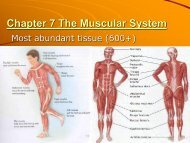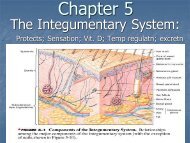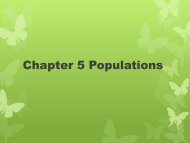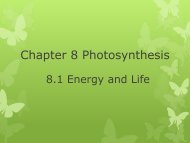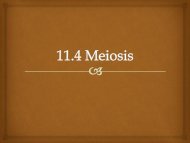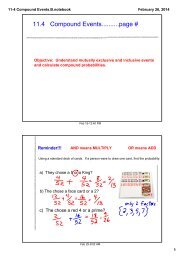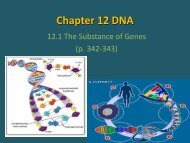Chapter 10 The Endocrine System.pdf
Chapter 10 The Endocrine System.pdf
Chapter 10 The Endocrine System.pdf
- No tags were found...
You also want an ePaper? Increase the reach of your titles
YUMPU automatically turns print PDFs into web optimized ePapers that Google loves.
<strong>Chapter</strong> <strong>10</strong><strong>The</strong> <strong>Endocrine</strong> <strong>System</strong>• <strong>The</strong> Nervous &<strong>Endocrine</strong><strong>System</strong>s regulatehomeostasis anddirect bodyactivities by therelease chemicalsignals
A. Functions1. Growth, metabolism, tissue maturation2. Blood glucose levels3. Ion regulation (Na + , K + , Ca ++ )4. Water balance5. Heart rate/bld pressure6. Immune system7. Reproductive functions8. Uterine contractions/milk release
B. Chemical Signals (CS)• Called ligands=to bind (molecules released toother location producing response)• Intracellular CS: within same cell• Intercellular CS: between certain cells; Types:
1. Autocrine: affects same cell type• Platelet CS w/inflam=>other platelets to clot2. Paracrine: affects different cells/same organ• Pancreas CS=>inhibits insulin cells within3. Hormones: intercellular by blood to organ
4. Neurotransmitter: intercellular nerve CS5. Pheromones: CS to environment affectingothers (influence menstruation)
C. Hormones• <strong>Endocrine</strong> (within; to separate): product releasedto distant targets by blood (adrenals)• Exocrine: product to duct to organ/skin (sweat)• Hormones/Neurohormone: CS (endocrine) thatinfluence activity of distant tissues• Target tissue: specific tissue w/receptor affectedby hormone
1. Hormone: Chemistry/Receptors:A. Water Soluble (proteins, peptides, AA):• Most membrane-bound receptors• Extend across membrane to produce response inside• Alter membrane permeability (channels open/close)
1. Activate G protein subunits• α subunit shifts, producing GDP=>GTP (energy) whichactivate enzymes causing response (open/close channel)2. Altering enzyme activity (increased/decreasedresponse)
Unemployment rate4 6 8 <strong>10</strong> 12German unemployment rateUnemployment rate in rest of EU% tending to trust the EU% tending to trust the German government25 30 35 40 45 50Trust2003 2005 2007 2009 2011 2013YearFigure 2. Unemployment in other European countries, German unemployment, trust in the Germangovernment, and German trust in the EU, 2003-2013. Sources: European Commission’s AMECO andEurobarometer databases.Altogether, previous scholarship has significantly improved our understanding of the determinants ofeuroscepticism by identifying the key domestic country- and individual-level factors that shape publicsupport for the EU. <strong>The</strong>se domestic factors, such as domestic economic outcomes, national identitiesor trust in national governments, certainly help explaining a large part of the variation in support forthe EU across European member states and citizens. Yet, as the financial crisis in the EU hashighlighted, a narrow focus on these domestic factors may ignore the potential role of developmentsand outcomes in other EU member states in shaping domestic attitudes towards the EU. 4 In particular,anecdotal evidence suggests that economic outcomes in other EU member states may have been an4 In line with this, recent research shows that international organisations and markets can significantly affectdomestic public opinion towards national political institutions (Armingeon and Guthmann 2013).ECB Working Paper 1815, June 2015 8
2. Receptor comparisonA. Intracellular signal slower (building proteins)B. Membrane bound faster (produces cascade ofsecondary signals)
3. Regulation (by negative feedback)A. Blood levels (glucose=insulin; Ca ++ =PTH)B. Other hormonesC. Nervous systemStress, Hypothermia↑metabolism↑ bodytemperature
D. <strong>Endocrine</strong> Glands andHormones
1. Pituitary (hypophysis): master gland• Connected to hypothalamus by infundibulum• Regulated by hypothalamus (endocrine controlcenter of brain) by either:
a) Releasing hormones to anterior pituitary through portalsystem (stimulate/inhibit pituitary hormones)
) Nerve cell bodies produce hormones that arereleased from posterior pituitary axon endings
A. Hormones of Anterior Pituitary1. Growth hormone (GH) – protein synth for growtha) =dwarfism; =giantism (w/excess abnormal featuresacromegaly)2. Thyroid-stimulating hormone (TSH) – reg thyroid3. Adrenocorticotropic hormone (ACTH)a) cortisol from adrenal glands (w/stress)b) skin pigmentation (similar structure to MSH)4. Gonadotropins – regulateovaries/testes5. Prolactin – milk production6. Melanocyte-stimulatinghormone (MSH) –melanin synthesis
B. Posterior Pituitary1. Antidiuretic Hormone (ADH)a) water reuptake by kidney ( urine)b) Constricts bld vessels w/lo BP(also called vasopressin)2. Oxytocin – uterinecontraction;milk let-down
C. Thyroid Glands1. Follicles produce hormones-require iodine (inUS=iodized salt): triiodothyronine=T 3 &tetraiodothyronin=T 42. TSH (from pituitary) regulatesa) W/lo levels of thyroid hormones = TSH;can lead to goiter (enlarged thyroid gland)3. Regulates growth & development in younga) Hypothyroidism: cretinism (mentalretardation, dwarfism)a) Hyperthyroidism: elevated metabolismeyes)(Grave’s Disease w/exophthalmia-bulging4. Regulates metabolism in mature5. Calcitonin (from C cells in CT betweenfollicles): lowers bld Ca levels by bindingto & inhibiting osteoclasts
D. Parathyroid Glands1. Parathyroid hormone: main bld Ca ++ regulator (w↓ levels)a) ↑ Vit D formatn in kidneys = ↑ SI uptake of Ca ++b) Bind osteoblast which release substance to ↑ osteoclast= ↑ Ca ++c) Hyperparathyroidism: bone loss; deform and fractured) Hypoparathyroidism: muscle cramps/tetanus
E. Adrenal GlandsA. Medulla: epinephrine/adrenalin – fight or flight• glucose; hrt rate; constriction SM BV (notskeletal)
1. Cortex:a) Cortisol (stress hormone): nutrient breakdown forenergy/reduces inflammation & suppressesimmune=w/hi stress=illness (cortisone - medicationgiven to reduce inflammation)b) Aldosterone:1) Released w/hi K+=retention of Na/water; Keliminated2) W /lo BP kidneys release renin (then angiotensin I toII = BV constriction & aldosterone release)
F. Pancreas, Insulin, diabetes• Brain needs constant supplyof glucose• W/low: fats/protein to fattyacids/AA pH -> acidosis• W/hi: glucose draws water tourine -> dehydration1. Pancreatic Islets (islets ofLangerhans)a) Insulin: beta cells affected bybld glucose levels (energymolecule)1) Glucose into target cell2) Targets liver, muscle,hypothalamus appetite center3) w/parasympathetic/w/sympathetic (exercise)
a) Diabetes: too little insulin; too few or defective receptors1) Hyperglycemia: very bld glucose ( urine, dehydration)2) insulin (hypoglycemia): w/diabetic shock shuts brain downb) Glucagon: (alpha cells) w/lo glucose => glycogen toglucose in liver
F. Testes/Ovaries1. Testosterone (males)/estrogen, progesterone(females): development/function reprod. sys.2. Hypothalamus/Anterior pituitary regulates w/FSH(follicle stimulating hormone) & LH (leutinizinghormone) – regulate reproductive timingG. Thymus (immune): thymosin hormoneregulates development of T cells (WBC)H. Pineal Body: melatonin decreases LH/FSH(shorter day length = melatonin)



